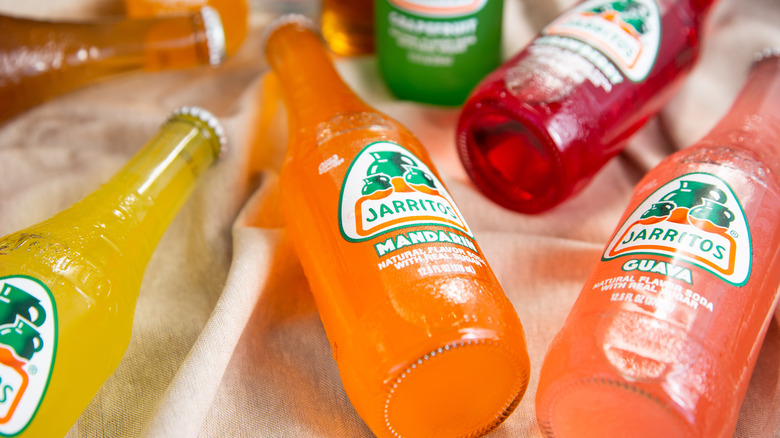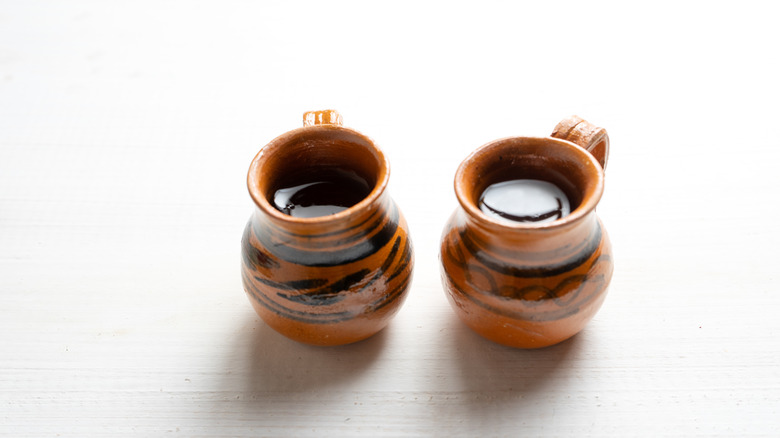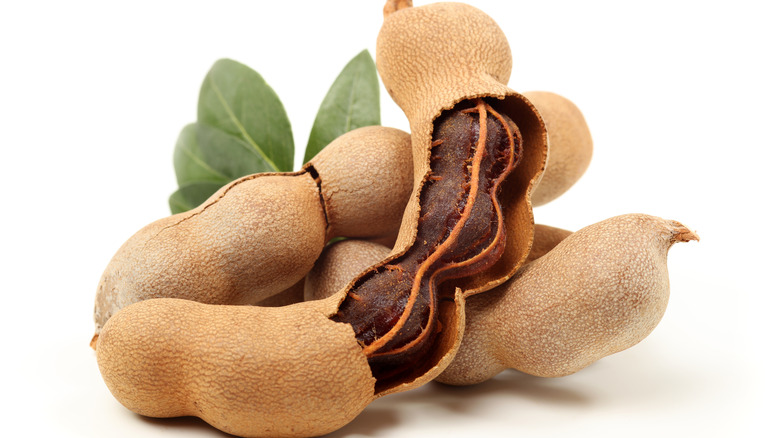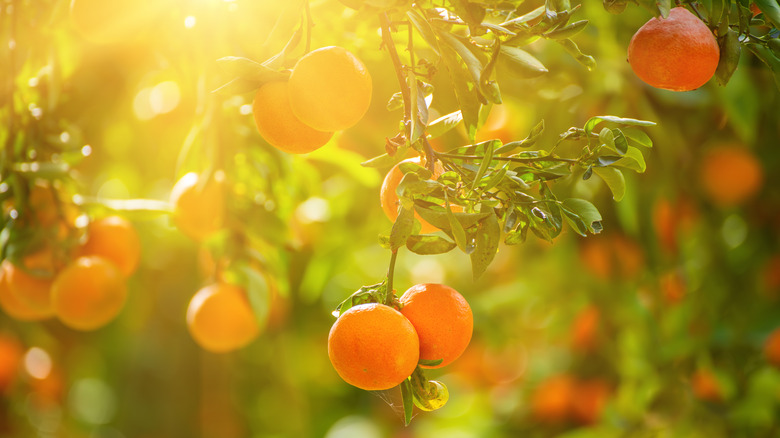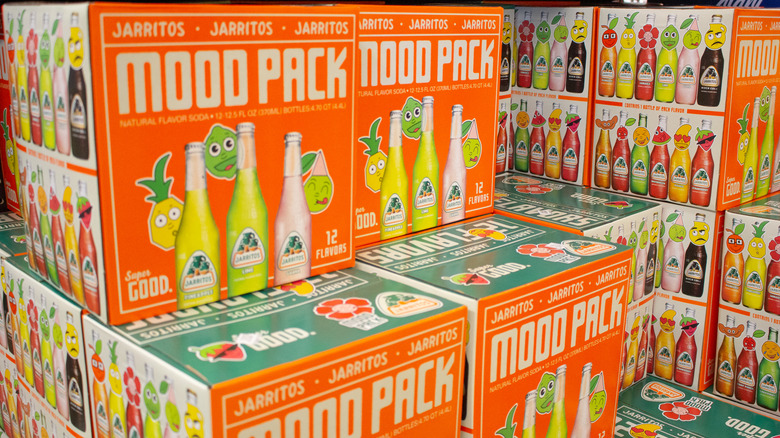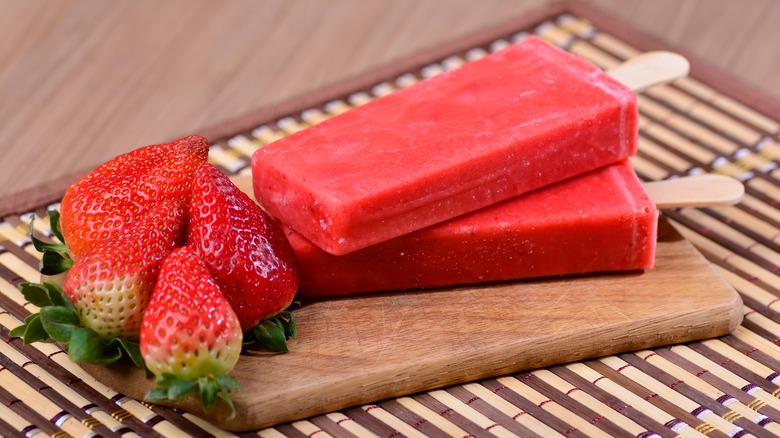The Untold Truth Of Jarritos
Every taqueria and taco truck worth its salt will have at least a couple of flavors of Jarritos sodas available for purchase to wash down your carne asada and carnitas tacos. Jarritos, which means "little jugs" in Spanish (referencing the little clay jugs from which people traditionally drink water in Mexico), was established in 1950 in Guadalajara, Mexico (via Mexican Soda Pop).
By 1960, the soda was already sold in 80% of all Mexican states, which is a huge market share to acquire in only a decade (via Jarritos). Jarritos was first introduced to the American market in 1988, and the move north seems to have paid off because now Jarritos is sold in about half of all big-name grocery stores in the United States, according to The New York Times.
With their clear glass bottles, retro labels, and vibrantly colored contents, Jarritos are pretty hard to miss when you're walking down the soda aisle. Whether you've tried every flavor or are a Jarritos newbie, we've got some fun facts you need to know about this soda brand.
Jarritos started with java
According to Serious Eats, Jarritos was born from a fusion of ideas and traditions. By 1950, Coca-Cola had become a household name, making sweet, carbonated beverages a popular staple. This inspired a man named Don Francisco Hill. Hill, who was also known as "El Güero," was a Mexican native and an "accomplished chemist and tinkerer," says the Jarritos website. Coca-Cola's stratospheric rise got him thinking.
Hill wanted to put a Mexican soda brand on the map. As Serious Eats explains, he was influenced by the traditional Mexican drink agua fresca, which combines water, sugar, and fruit. What if he could capture that flavor potential, but carbonated? Interestingly, however, when Hill first debuted Jarritos, it wasn't with a fruit flavor at all. In 1950, he introduced a coffee-flavored soda. For a wider market, Hill might have been a little ahead of his time. Today, coffee sodas are having a moment, from Pepsi's coffee colas to inventive concoctions from smaller brands (via Gear Patrol). Back in 1950, however, Hill saw the benefit of going back to the drawing board and wooing more soda drinkers with those agua fresca-like fruit flavors.
An early Jarritos flavor is still a hit today
The Jarritos website says that when Hill decided to nix the coffee soda for fruit varieties, the first addition to what would become a vibrant portfolio was mandarin. The next flavor was tamarind, which was an exciting debut for a soda flavor because Hill had to do his signature tinkering to figure out to best get juice from this fruit.
According to The Chicago Tribune, tamarind is a fruit pod from a type of tree native to Asia and northern Africa. Tamarind is versatile: its taste is both sweet and sour, and leans more in one direction or the other depending on how ripe it is. Think of lemons, apricots, and dates for comparable flavor profiles. Plus, it can be used in both sweet and savory recipes. You'll find tamarind in everything from candies to curries to Worcestershire sauce.
Having a tamarind-flavored soda is still a unique claim to fame for Jarritos, and people love it now as much as they did when it came out in the 1950s. Serious Eats says Tamarind is Jarritos's second best-selling variety.
Jarritos is made with natural sugar and carefully sourced ingredients
Jarritos stands out from other sodas available today, and not just because of its retro-cool glass bottles or its bright colors — colors so vivid, in fact, that Jarritos says in its early days, they didn't even label the sodas because people knew the flavors by their respective hues.
Jarritos isn't as strongly carbonated as other modern soft drinks, Soda Pop Craft notes, and has a different sort of sweetness because it is made with all natural cane sugar in Mexico instead of high fructose corn syrup, which is the more common sweetener for big American sodas like Coke (via HuffPost). People who like the flavor of Mexican Coca-Cola, which is still made with cane sugar and not corn syrup, might want to give Jarritos a try next.
Another major difference from American sodas is that Jarritos works hard to source its fruits responsibly and locally. Its different flavors include: Mandarin, Strawberry, Lime, Tamarind, Guava, Grapefruit, Fruit Punch, "Mxcn" Cola, Pineapple, Jamaica (hibiscus), Mango, Watermelon, and Passion Fruit. "As Jarritos has grown over the years, we've always sourced as much fruit as possible from different Mexican regions," the brand's website reads. For their Mandarin flavor, Jarritos even has its own mandarin groves in Yucatán.
Jarritos maintains strong sales with savvy marketing
The New York Times writes that Jarritos is sold in about half of United States grocery stores and has annual sales of over $2 million, as of 2011. The brand is also available in other countries, from France and Italy to Australia. Jarritos says that 1,500 bottles are exported every minute — and the company has no problem keeping up, considering 45,000 glass bottles can be filled every hour at any of their plants in Mexico.
Jarritos could rely on its delicious soda, variety of flavors, vibrant history, fun colors, natural sweetness, flair for pairing with tacos, or all of the above in order to keep up this kind of pace. But the brand has also paid close attention to what a little extra advertising can do. Some stunts include making deliveries via luchadores on bicycles, which Electric Cyclery experienced in 2014. In 2011, The New York Times reported on a push by Novamex, the El Paso, Texas company that now owns Jarritos and markets it outside of Mexico. Novamex set out to introduce a younger generation to Jarritos through street art and creative videos. You can still pick up on a cool, artsy vibe on the Jarritos Instagram page today.
The possibilities are endless when it comes to Jarritos recipes
With so many flavors, Jarritos are easy to enjoy and savor totally on their own. They also pair well with an endless list of foods, considering their wide flavor range and the fact that their mixes of bubbliness, sweetness, and tartness are easy complements to practically any cuisine. That's not the only way to experience Jarritos sodas, though.
Jarritos make effortless and tasty additions to tons of recipes. You can find plenty of these right on the brand's website. One quick, fun, delicious, and refreshing idea is to make Jarritos paletas, traditional Mexican popsicles. While we're on the topic of frozen desserts, how about Jarritos ice cream floats? There are also limitless opportunities to channel your inner mixologist with Jarritos, too, like a Jarritos margarita. You can even braise your tacos in Jarritos! Basically, whether you pair your food with Jarritos or actually make your food using Jarritos, this fruity Mexican soda is a great addition to any meal or snack.
